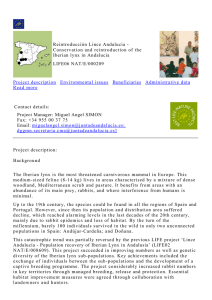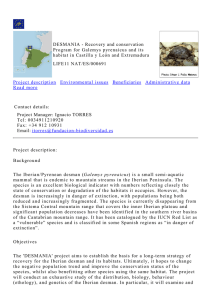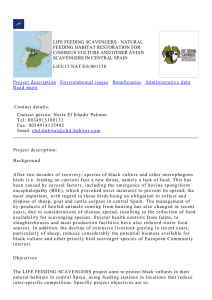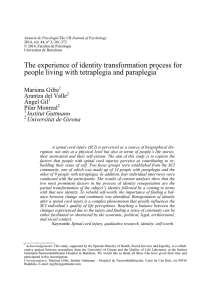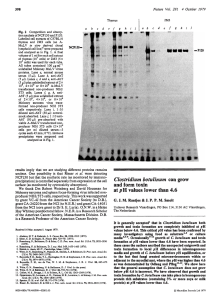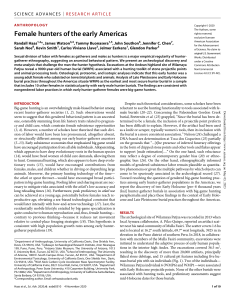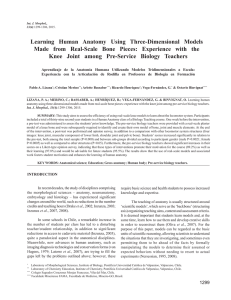PDF version
Anuncio
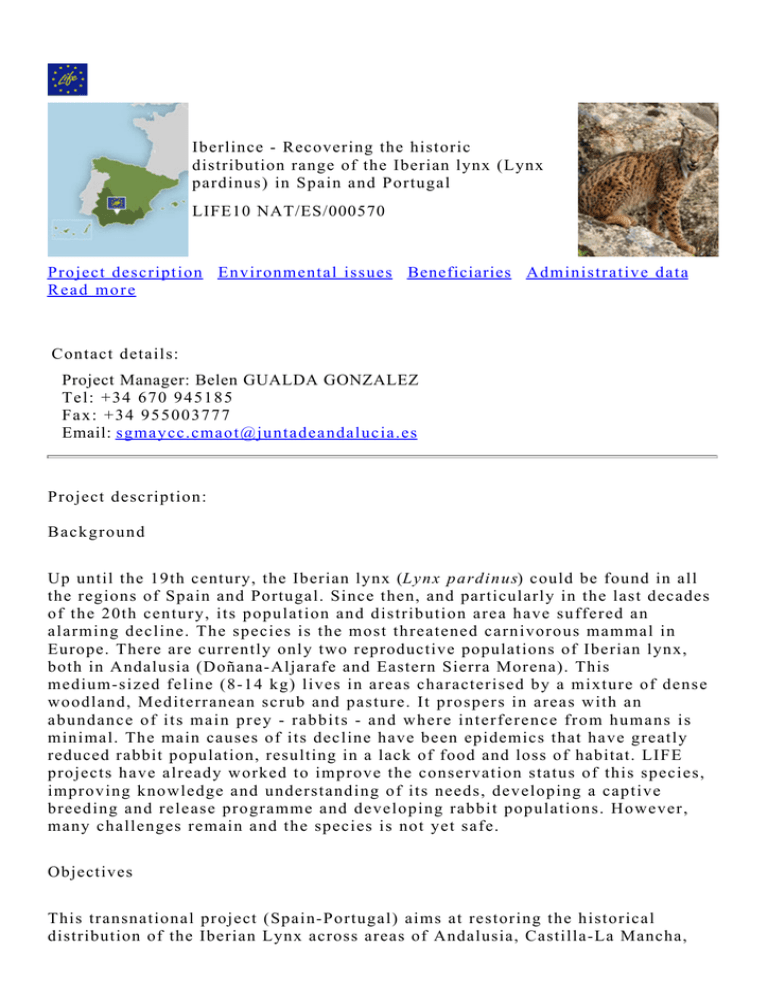
Iberlince - Recovering the historic distribution range of the Iberian lynx (Lynx pardinus) in Spain and Portugal LIFE10 NAT/ES/000570 Project description Environmental issues Beneficiaries Administrative data R e a d m o r e Contact details: Project Manager: Belen GUALDA GONZALEZ Tel: +34 670 945185 Fax: +34 955003777 Email: sgmaycc.cmaot@juntadeandalucia.es Project description: Background Up until the 19th century, the Iberian lynx (Lynx pardinus) could be found in all the regions of Spain and Portugal. Since then, and particularly in the last decades of the 20th century, its population and distribution area have suffered an alarming decline. The species is the most threatened carnivorous mammal in Europe. There are currently only two reproductive populations of Iberian lynx, both in Andalusia (Doñana-Aljarafe and Eastern Sierra Morena). This medium-sized feline (8-14 kg) lives in areas characterised by a mixture of dense woodland, Mediterranean scrub and pasture. It prospers in areas with an abundance of it s m ai n p rey - ra b b i t s - a n d wh e r e i n t e r f e r e n c e f r o m h u m a ns is minimal. The main causes of its decline have been epidemics that have greatly reduced rabbit population, resulting in a lack of food and loss of habitat. LIFE projects have already worked to improve the conservation status of this species, improving knowledge and understanding of its needs, developing a captive breeding and release programme and developing rabbit populations. However, many challenges remain and the species is not yet safe. Objectives This transnational project (Spain-Portugal) aims at restoring the historical distribution of the Iberian Lynx across areas of Andalusia, Castilla-La Mancha, Extremadura (all in Spain) and Portugal. The project will work to reinforce Extremadura (all in Spain) and Portugal. The project will work to reinforce numbers of the species in the existing populations, and establish new populations in areas identified as appropriate. The project will introduce individual animals both bred in captivity or captured elsewhere to increase the numbers of animals in the existing populations and increase the genetic diversity of these populations. It will also seek to increase their breeding and survival rates by continuing work to improve the habitat to favour the species and particularly to facilitate a quantifiable increase of connectivity between population cores through corridors. The project will continue to develop measures to improve the co-operation of relevant stakeholders in protecting the species, particularly landowners, hunters and road users. These combined actions seek to decrease the mortality of the species from accidental road death, furtive hunting and pursuit and other negligent activities, including poisoning. The project will carefully identify areas with sufficient resources for the reintroduction of self-sustaining populations of lynx in Portugal, Castilla-La Mancha, Extremadura and Andalusia. It will then use habitat-improvement and threat-reduction measures and strategic release to try to establish four new Iberian lynx populations, each with five territorial females, in the most suitable of these. Expected results: Increase the numbers of existing Iberian lynx populations to 70 territorial females in Eastern Sierra Morena and 25 in Doñana-Aljarafe; Increase the heterozygosity of existing populations by 7% in Doñana-Aljarafe and by 3% in Eastern Sierra Morena; Decrease in mortality rates of the species from different identified causes: road kill by 30%; furtive hunting and pursuit by 20%; other negligence by 10%; and infectious diseases by 10%; Establish four new Iberian lynx populations with five territorial females each in different SCIs where the species was present historically; and Achieve a specimen fixation rate of no less than 50% from the released individuals and a recruitment of no less than 33% from the reintroduced females. Results Top Environmental issues addressed: Themes Species - Mammals Keywords endemic species‚ introduction of animal species Target species Lynx pardinus Natura 2000 sites SCI ES0000024 SCI ES0000050 SCI ES0000051 SCI ES0000052 SCI ES0000053 SCI ES4210016 SCI ES4250005 SCI ES4310045 SCI ES4320002 SCI ES4320013 SCI ES6130001 SCI ES6130003 SCI ES6130004 SCI ES6130005 SCI ES6130006 SCI ES6130007 SCI ES6140006 SCI ES6150009 SCI ES6150010 SCI ES6150012 SCI ES6150021 SCI ES6150022 SCI ES6150023 SCI ES6160005 SCI ES6160006 SCI ES6160008 SCI ES6180005 SCI ES6200003 SCI ES6200018 SCI ES6200035 SCI PTCON0004 SCI PTCON0036 SCI PTCON0053 SCI ES4320077 Top Beneficiaries: DOÑANA SIERRA DE HORNACHUELOS SIERRA DE ARACENA Y PICOS DE AROCHE SIERRA PELADA Y RIVERA DEL ASERRADOR SIERRA NORTE SIERRA DEL RELUMBRAR Y ESTRIBACIONES DE ALCARAZ MONTES DE TOLEDO VALDECIGÜEÑAS Cedillo y Río Tajo Internacional GRANADILLA SIERRA DE CARDEÑA Y MONTORO SIERRA DE SANTA EUFEMIA Río Guadalmez SUROESTE DE LA SIERRA DE CARDEÑA Y MONTORO GUADALMELLATO GUADIATO-BEMBEZAR SIERRA DE ARANA DOÑANA NORTE Y OESTE Andévalo Occidental DEHESA DEL ESTERO Y MONTES DE MOGUER Corredor Ecológico del Río Tinto RIVERA DE CHANZA DEHESA DE TORRECUADROS Y ARROYO DE PILAS DESPEÑAPERROS SIERRAS DE ANDÚJAR CUENCAS DEL RUMBLAR, GUADALEN Y GUADALMENA Corredor Ecológico del Río Guadiamar Sierra de La Pila Sierra de la Muela Sierra de Almenara Malcata Guadiana Moura / Barrancos MONFRAGÜE Coordinator Type of organisation Description Partners Consejería de Medio Ambiente. Junta de Andalucía. Regional authority Consejería de Medio Ambiente (Junta de Andalucía), is the regional ministry for the environment in Andalusia, with full powers in nature conservation. Instituto da Conservação da Natureza e da Biodiversidade-Ministério do Ambiente e do Ordenamento do Território, Portugal Organismo Autónomo de Parques Nacionales (Ministerio de Medio Ambiente, Medio Rural y Marino), Spain Consejería de Industria, Energía y Medio Ambiente (Junta de Extremadura), Spain Consejería de Agricultura y Medio Ambiente (Junta de Comunidades de Castilla – La Mancha), Spain Consejería de Medio Ambiente (Comunidad Autónoma de la Región de Murcia), Spain Federación Extremeña de Caza (FEDEREX), Spain Empresa de Gestión Medio-Ambiental Sociedad Anónima (EGMASA), Spain Federación Andaluza de Caza (FAC), Spain Consejería de Obras Públicas y Transportes (Junta de Andalucía), Spain Consejería de Agricultura y Pesca (Junta de Andalucía), Spain Sociedad Española para la Conservación y Estudio de los Mamíferos (SECEM), Spain Fundación CBD-Hábitat, Spain Ecologistas en Acción Andalucía, Spain sociación de Propietarios Rurales, Productores de Caza y Conservadores del Medio Natural de España (APROCA), Spain Arturo Menor (ACAJÚ), Spain WWF-España Asociación para la Defensa de la Naturaleza de Extremadura (ADENEX), Spain Top Administrative data: Project reference Duration Total budget EU contribution Project location Top LIFE10 NAT/ES/000570 01-SEP-2011 to 31-DEC -2017 34,015,188.00 € 20,943,399.00 € Extremadura(España),Andalucía(España),Murcia(España) Read more: Project web site Project's website Top Project description Environmental issues Beneficiaries Administrative data R e a d m o r e
